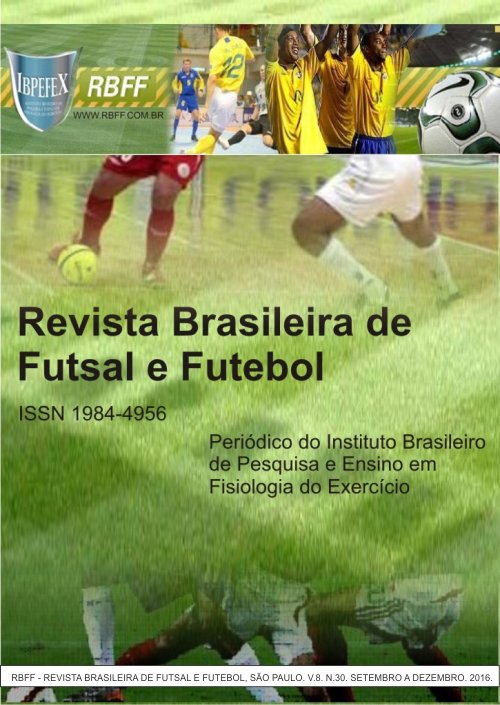Comparative study of heart rate and estimated maximum in professional football players in different equation
Abstract
The maximum heart rate is considered the highest HR during an effort to exhaustion, being used as a criterion in progressive exercise tests. Among the equations to estimate the FCM, the equation 220-age, and the most commonly used, other equation and Tanaka et al (2001) in which overestimates the FC based on age. Thus the objective of this study was to compare the MHR obtained through exercise stress test in two groups of professional football players, with different ages, with the prediction formulas proposed by Tanaka et al. (2001) and 220 age and compare them which are closer to each group held FCM. The subjects were divided into two groups G1 (n = 11): (age: 27.4 ± 2.3, weight 76.3 ± 8.4 kg 180.9 ± 9.2 cm height) and G2 (n = 12): (age 20.5 ± 2.1, 69.5 ± 7.4 kg weight, height 175.25 ± 8.5 cm). The results showed that the FCM reached in the test G1 and G2 was similar in both formulas, regardless of age, compared with the formulas G1 has an FCM under estimated by both formulas as G2 had a high FCM in formula 220 -Age compared with FCM achieved in tests, as interesting was the change in the formula 220-age data compared to Tanaka's formula and colleagues (2001), due to age. Differ in groups of different ages, some equations may estimate an FCM, no more accurately, because individual responses, it is emphasized in athletes individuals, since margin of error is larger.
References
-American College of Sports Medicine. ACSM’s Guidelines for Exercise Testing and Prescription. Philadelphia. Lippincott Williams & Wilkins. 2009.
-Araujo, C. G. S; Pinto, V. L. M. Freqüência Cardíaca Máxima em Testes de Exercício em Esteira Rolante e em Cicloergômetro de Membros Inferiores. Arquivos Brasileiros de Cardiologia. Vol. 85. Núm. 1. 2005.
-Barbosa, F. P.; Oliveira, H. B.; Fernandes, P. R.; Fernandes, F. J. Estudo Comparativo de Equações de Estimativa da FC Máxima. Fitness and Performance Journal. Vol. 3. p. 108-114. 2004.
-Camarda, S. R. D. A.; Tebexreni, A. S.; Páfaro, C. N.; Sasai, F. B; Tambeiro, V. L.; Juliano, Y.; Barros Neto, T. L. Comparação da frequência cardíaca máxima medida com as fórmulas de predição propostas por Karvonen e Tanaka. Arquivos Brasileiros em Cardiologia. São Paulo. Vol. 91. Núm. 5. p. 311-314. 2008.
-Caputo, E. L.; Da Silva, M. C.; Rombaldi, A. J. Comparação da frequência cardíaca máxima obtida pordiferentes métodos. Rev. Educ. Fis/UEM. Vol. 23. Núm. 2. p. 277-284. 2012.
-Machado, F. A.; Denadai, B. S. Validade das equações preditivas da frequência cardíaca máxima para crianças e adolescentes. Arquivos Brasileiros de Cardiologia. Vol. 97. p. 136-140. 2011.
-Karvonen, M. J.; Kentala, E.; Mustala, O. The effects of training on heart rate: a longitudinal study. Ann Med Exper Fenn. Vol. 35. Núm. 3. p. 307-315. 1957.
-Kindermann, M.; Schwaab, B.; Finkler, N.; Schaller, S.; Böhm, M.; Fröhlig, G. Defining the optimum upper heart rate limit during exercise: a study in pacemaker patients with heart failure. European Heart Journal. Vol. 23. p. 1301-1038. 2002.
-Policarpo, F. B.; Fernandes Filho, J. Usar ou não a equação de estimativa “220 -idade?”. Rev Bras Cienc Mov. Vol. 12. p. 77-79. 2004.
-Robergs, R. A.; Landwehr, R. The surprising history of the “HRmax=220-age” equation. JEPonline. Vol. 5. Núm. 2. p. 1-10. 2002.
-Silva, V. A. P.; Bottaro, M. Justino, M. A.; Ribeiro, M. M.; Lima, R. M. Oliveira, R. J. Freqüência cardíaca máxima em idosas brasileiras: uma comparação entre valores medidos e previstos. Arquivos Brasileiros de Cardiologia. Vol. 88. p. 314-320. 2007.
-Silva, P. R. S.; Romano, A.; Yazbek Jr, P.; Battistella, L. R. Efeito do treinamento físico específico nas respostas cardiorrespiratórias e metabólicas em repouso e no exercício máximo em jogadores de futebol profissional. Rev Bras Med Esporte. Vol. 3. Núm. 4. 1997.
-Tanaka, H.; Monahan, K. D.; Seals, D. R. Age-predicted maximal heart rate revisited. Journal of American College of Cardiology. Vol. 37. p. 153-156. 2001.
-Tibana, R. A.; Barros, E.; Brito Silva, P.; Da Silva, R. A. S.; Balsamo, S.; Souza Oliveira, A. Comparação da Frequência Cardíaca Máxima e Estimada por Diferentes Equações. Brazilian Journal of Biomotricity. Vol. 3. Núm. 4. p. 359-365. 2009.
-Wilmore,J. H; Costill, D. L. Fisiologia do esporte e do exercício. 5ª ed. São Paulo: Manole. 2013.
Authors who publish in this journal agree to the following terms:
- Authors retain the copyright and grant the journal the right of first publication, with work simultaneously licensed under the Creative Commons Attribution License BY-NC which allows the sharing of the work with acknowledgment of the authorship of the work and initial publication in this journal.
- Authors are authorized to enter into additional contracts separately for non-exclusive distribution of the version of the work published in this journal (eg, publishing in institutional repository or book chapter), with acknowledgment of authorship and initial publication in this journal.
- Authors are allowed and encouraged to post and distribute their work online (eg, in institutional repositories or on their personal page) at any point before or during the editorial process, as this can bring about productive change as well as increase impact and impact. citation of published work (See The Effect of Free Access).





